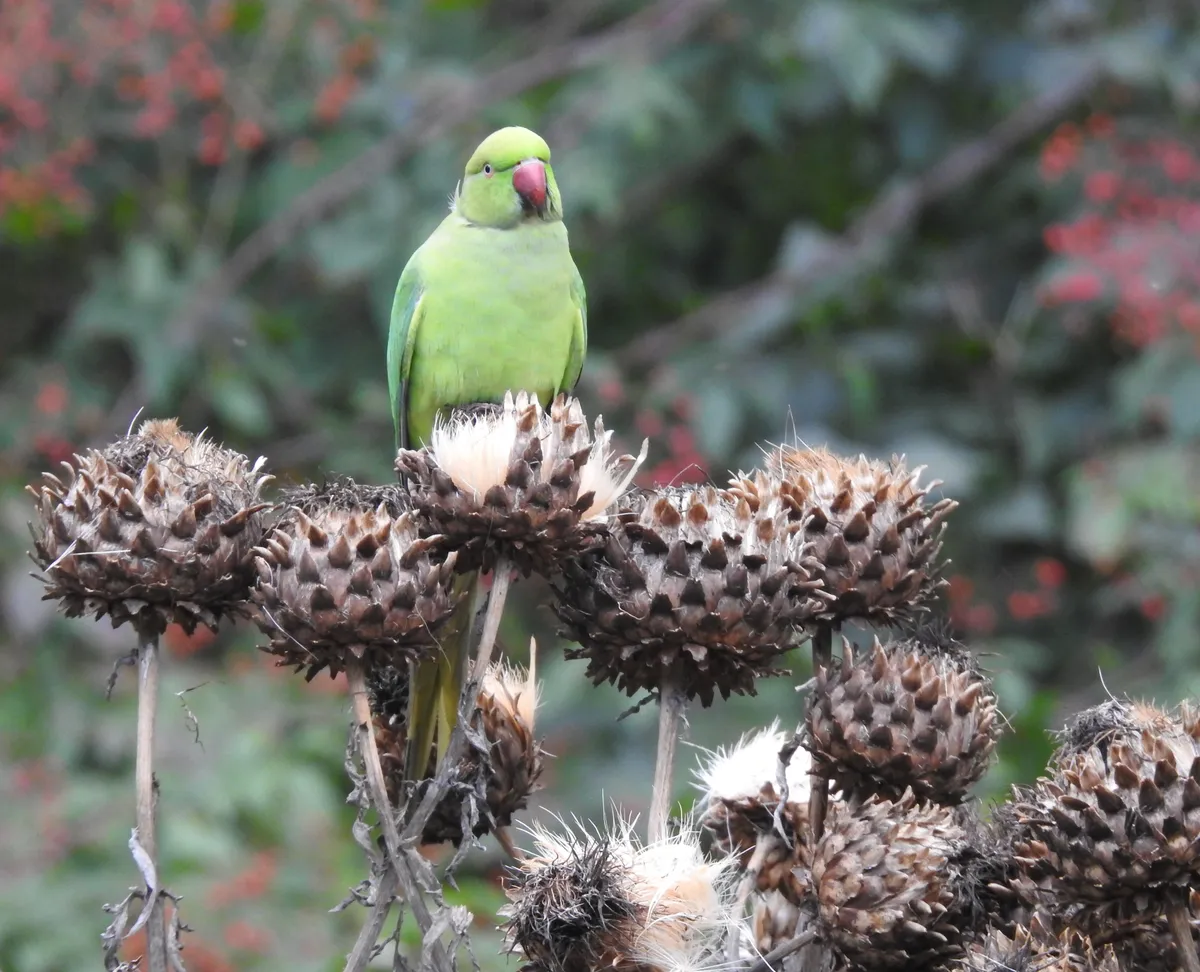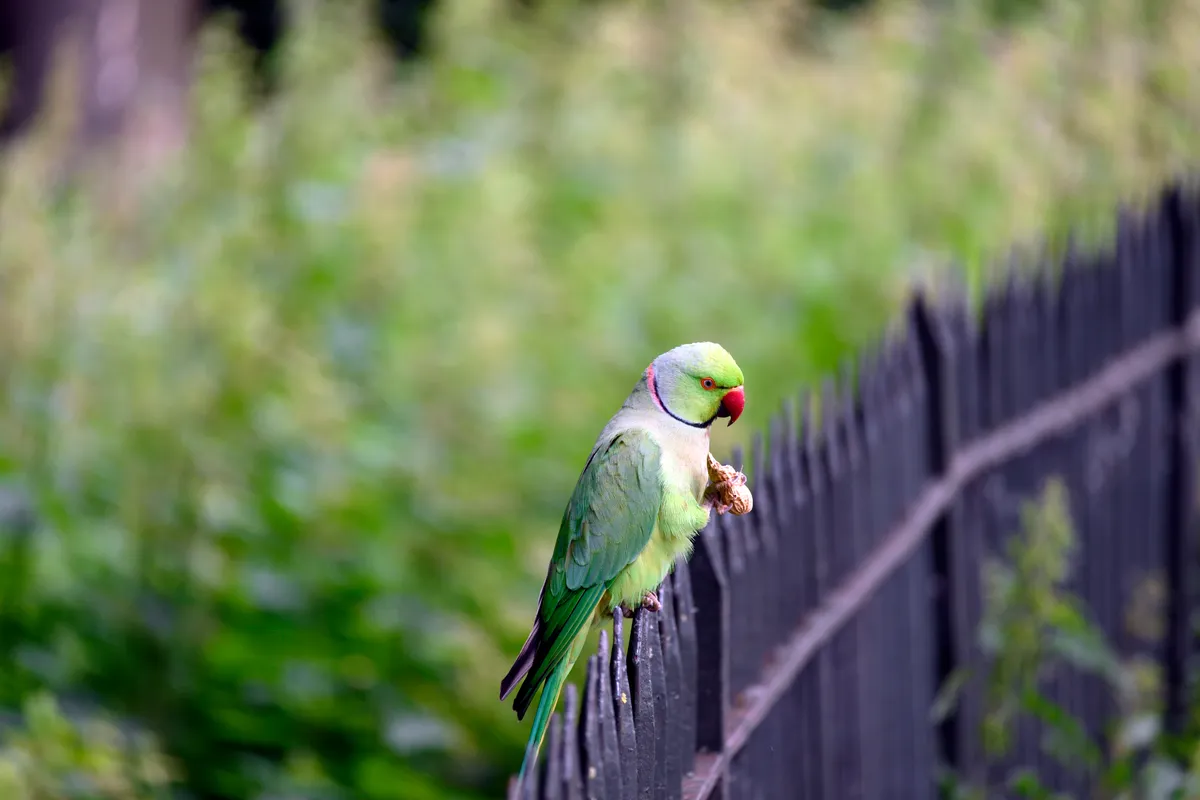Surely everyone must have heard of the Red Arrows, but Britain now has its own wild equivalent in the form of a burgeoning population of ring-necked parakeets.
Impossible to miss while either tearing across the sky in British towns and cities, or when forming large and raucous winter roosts, the future for this introduced species appears to be as bright as its plumage.
Why do we have wild ring-necked parakeets in the UK?
Myths abound as to how this colourful addition to our avifauna first came to settle in London. One popular theory was that the birds escaped from the Shepperton Studios’ set of the 1951 film The African Queen, while another rumour was that Jimi Hendrix released a pair in London’s Carnaby Street as a gesture of peace and love in 1968.
However, the more prosaic truth is that their original introduction and subsequent spread was a consequence of repeated releases and escapes from captivity. Not recorded as breeding in the wild until 1969, the most recent survey suggested that 12,000 pairs bred in Britain in 2016, with the population continuing to steadily rise.

What do ring-necked parakeets look like?
About the size of a collared dove, with a long pointed tail and rounded head, the feature that always strikes you first when taking in the parakeets is that emerald-green plumage. These ‘posh pigeons’ also possess a deeply hooked and crimson-red coloured bill, with the males developing a delicate black-and-pink collar and bluish nape during the breeding season. As their flights are often accompanied by a harsh, screeching ‘kee-ak’ call, they’re also frequently heard well before being seen.
Where do ring-necked parakeets come from?
Comprising four different subspecies in their African and Asian ancestral homes, DNA research work from the University of Kent has traced the majority of our parakeets back to populations from Pakistan and northern regions of India. In the Indian subcontinent, many of the parakeets are found in the Himalayan foothills, which may well explain why they find our winter climate such a breeze.

What do ring-necked parakeets eat?
Undoubtedly also helped by a recent run of mild winters, the parakeets’ expansion outside their core populations in north Kent and South West London must also be due to our passion for bird-feeding. Small parties will visit gardens for peanuts and sunflower hearts during winter when more natural foodstuffs are in shorter supply, but the place to catch up with large numbers is at a few, select winter night-time tree roosts.
Ring-necked parakeets have become so familiar with people in London's parks, they will land on the palms of visitors to feed. Long after Ken Livingstone banned folk feeding the pigeons in Trafalgar Square, a similar situation has sprung up in some of London’s green spaces where bold ring-necked parakeets will land on the hand of anyone offering food.
When can I see ring-necked parakeets?
With a December dusk approaching, birds begin arrowing towards the roost from distances of up to 25km away. As small flocks begin coalescing closer to the roost, this can turn into quite an aerobatic display where the birds tumble out of the sky down to a tree-top branch, on which they’ll spend the night. The accompanying soundtrack as the birds fly in from their feeding areas also has to be heard to be believed.

Why do ring-necked parakeets roost together?
In many communally roosting birds this behaviour is at least partly thought to be a mechanism for deterring potential predators, as each parakeet, for example, will achieve a higher level of personal safety by keeping in the crowd. Sparrowhawks or peregrines will find it harder to pick out a single target from among the rapidly moving flocks. Another purpose of these night-time roosts may be to serve as an information exchange, whereby birds that fed poorly during the day could potentially follow better fed birds out of the roost the following morning.
Are wild ring-necked parakeets a problem?
The parakeets can sometimes dominate garden bird feeders, making it harder for our smaller native species to feed, and they may also compete with nuthatches, woodpeckers and even bats for tree holes. However, the scientific community currently appears hesitant to label these brightly-coloured invaders as a problem in the UK, preferring instead to monitor the situation. So, with Christmas just around the corner, why not take a break from shopping and conduct a spot of impromptu parakeet monitoring yourself? You can use the BirdTrack app, which is managed by the BTO, among others.

Are there any other wild parakeets in the UK?
In amongst the massed ranks of ring-necked parakeets, do look out for the occasional monk parakeet. Hailing from the tropical forests of Brazil and Bolivia, these escapees have caused problems due to their habit of nesting on pylons and phone masts, resulting in Defra controlling numbers.
Best places to see roosting ring-necked parakeets in the UK
Victoria Park, Glasgow
A small population of parakeets have recently made their home in this Glasgow park, making them surely the most northerly flock of parrots in the world.
Platt Fields Park, Manchester
Parakeets are now seen in conurbations across north-west England, and the island at the centre of the lake in this Manchester park is a great place to watch them roosting.
Ramsgate, Kent
Winter roosts can be found anywhere from Ramsgate’s station to the town’s cemetery. The Kent enclave is the largest outside of Greater London.
Hither Green Cemetery, London
One of the largest winter roosts in London converge on the poplars between the cemetery and crematorium in South East London.
Richmond Park, London
The largest of London’s parks is a great place to catch up with ring-necked parakeets at any time of year. They also breed in a number of the National Nature Reserve’s old trees.
Main image: Ring-necked parakeets squabbling on bird feeders in an urban London garden © Georgette Douwma/Getty
